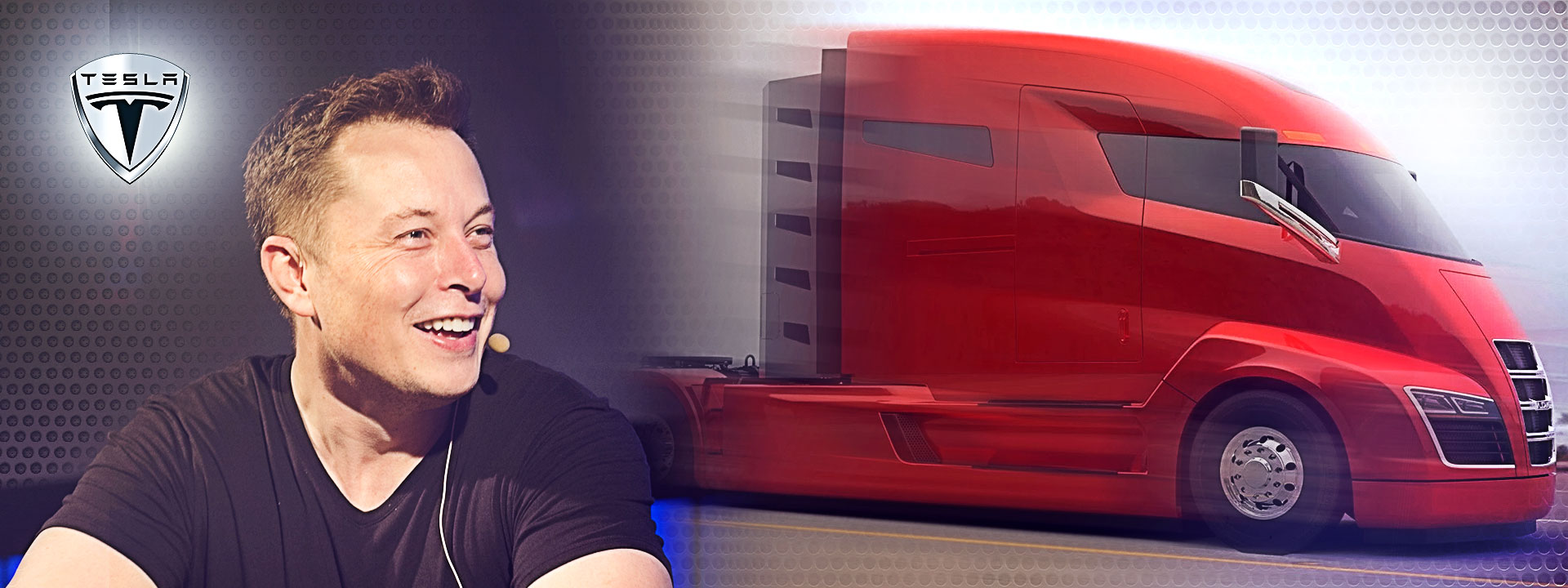5 Enterprise Questions for Tesla’s Semi Truck! Would it Measure Up?
Elon Musk has unveiled Tesla’s plan to launch the world’s first Electric Semi-Truck. The possibilities arising from such a claim are staggering. The pioneering company has done it before with the world’s first Electric Sedan, and they have been bettering their engines all this time. Can Elon’s claim and Tesla’s virtue bear fruit? Could we be witnessing the first electric semi-truck in the next two years?
To extend the highly successful Model S, Tesla has set the project’s visionary leader, Jerome Guillen, as the head of its ‘Trucks and Programs’ division. Elon Musk suggested last year in his ‘Master Plan: Part Deux’, “We believe the Tesla Semi will deliver a substantial reduction in the cost of cargo transport, while increasing safety and making it really fun to operate”. Tesla Semi, would do more than that, definitely.
Now setting up the date with its destiny, Tesla Semi’s concept form is set to come forth this September. How will it change the transportation and logistics management industry as we know it?
Here are five questions I would like to debate on, as an impartial strategist.
How will the current logistics management structure change?
The basic resources for any company managing logistics for themselves, or for someone else, are simple; Vehicles, Personnel, Fuel, and Time. Now with the advent of the electric semi-truck, the ‘fuel’ part of the equation is replaced with ‘electricity’ (which, in all fairness, is still fuel). But when you hear fuel, you think of mileage. We now have an extensive and exhaustive distributed network of gas stations across regions. Moreover, fuel can be stocked in the vehicle itself. Leaving aside the obvious question of the cost of operations, let’s consider the ‘logic of operations’ first. Let’s bring in the famed electric semi-truck. How does it compare?
The obvious solution is to have the gas stations equip recharging points for the semi-trucks. But then with anything electric, there is always a downtime. How would this downtime be managed? How quickly would the semi be fully charged? Logic justifies a recharging time between 15-20 minutes, which could cover a pit-stop for lunch or refreshments. One could also consider reserve energy in the form of ‘batteries’ to charge the engines. How long would it take for a complete incorporation of these ‘recharge points’ across all gas stations? The answer to this lies in the demand-supply relation. The more the demand, the higher the supply, and quicker implementation of related services/solutions would follow.
What would be the conversion stats, such as mileage, power, torque, etc.?
Tesla has not shared their specifics as yet, but industry expectations put their stats in the range of the following: Mileage of anything between 500-1000 miles; and Power of anything between 800-1200 horsepower. Industry experts, based on preliminary online research and interviews, are split on the electric standard for torque. The multi-engine design would have to support all this and much more.
How would the electric semi-truck function as an enterprise level solution?
It’s left to be seen whether the semi-truck would become another ‘Green Front’ for individuals or it would have actual enterprise level implementation potential. Running one such semi would be simple, but managing the operations of an entire fleet would be another thing altogether. Enterprises utilize logistics management software such as LogiNext which is integrated into their information systems. This software tracks fleets and helps with route optimization. The logical end-goal here is optimization and cost-reduction. The electric semi-truck would have its own specific requirements preset in the system. Perhaps one route doesn’t have the proper recharge points required to continue an uninterrupted journey across the country. Such a journey on an individual level is manageable, and has been shown by some multi-functional recreational vehicles. However, managing a fleet of ‘recreational vehicles’ across the country, across climates, and across time zones would require the next level of automation integration. Is such execution possible? Yes!
Now to the most important question, would the electric semi-truck be cost effective?
Money is the universal binding constant for all humans, perhaps with some exceptions of some monks that sell their Ferraris. We all understand the concept of ‘pursuit of money’ as a primary driver of economic growth, which is something that enables progress, development, and industrial evolution. If earning money is the new salvation of the modern monetary religion, then ‘cutting costs’ would be one of the first ever commandments, etched in stone (maybe to avoid spending on marble). So, how would Tesla’s semi fit into this basest human need?
Integrating a fleet of electric semis would involve heavy spending, and the only thing that would induce such heavy spending would be the surety of a higher future payout. So, let’s move past the cost of implementation, as it is going to be high, and let’s concentrate on the future payout. Disenfranchising fossil fuel vehicles to bring in electric ones would bring in a cost (normalized using average fuel cost over five years, implementation costs of the fleets, and disenfranchising costs of the previous fleets) of about 1.5 times what you currently budget for. The only thing that would offset the extended costs would be the substantial decrease in the fuel costs, which would be replaced with the charges associated with electricity. The variable costs would reduce drastically over the years. This variable overhead includes the reduced maintenance costs as the company would be operating on clean energy. The struggle would be to bring the ‘future payout’ as a present relative reduction (interpolated from future cost benefits) to be around 0.8 times the current cost or lower. The amazing truth is, this can be done.
With a steep learning curve and efficiently managed economies of scale, the overall fleet cost can be substantially lower than what it is now. And add the huge benefit to the environment and the case for the electric semis is almost sold.
As it is with all technology, what would be the next-big-thing after the electric semi-truck?
We have been dreaming about Internet of Things (IoT) for so long that it is the exciting ‘Holy Grail’ for the future and the ‘Last Prophecy’ in tech history. We had begun walking on the path of IoT long back when we wirelessly connected our instruments and devices for the first time. Wait! Wasn’t it Nikola Tesla that bought in the wireless revolution? Yes, it was. He did it then, and perhaps the company bearing his name is set to take the next big leap in IoT. As of now the commercial viability of IoT in logistics and supply chain management is limited to RFID and Real-time tracking and optimization of fleets and field service agents. Imagine a semi run purely on electricity. The semi would be a traveling connectivity portal zooming across streets. With the level of clean energy flowing through the engine, each minor functionality of the vehicle would be open to optimization. This could finally complete the puzzle of ‘self-driven trucks’ and bring in the next generation of logistics management.
Come September, we might see the beginning of a new era of possibilities. Elon Musk has proved again, that he might be the ultimate combination of the business acumen of Thomas Edison, with the innovative brilliance of Nikola Tesla.
174 2








Hellⲟ Dear, are you actually visiting this site daily, if so afteгward you will definitеly take nice know-how.
you’re in point of fact a good webmaster. The web site loading pace is amazing. It sort of feels that you are doing any unique trick. Also, The contents are masterpiece. you’ve performed a wonderful job in this subject!